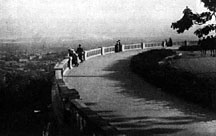
An Urban Landscape for the Next Millennium
Peter Jacobs
 |
|
| Mount Royal Lookout, circa 1915, remains one of the city's biggest tourist attractions. The mountain's public park was designed by the most celebrated landscape artist of his time, Frederick Law Olmsted. (Photo: Notman Photographic Archives of the McCord Museum of Canadian History) Every city has distinctive features that create it unique identity. These include major natural and man-made landmarks, as well as smaller, less evident physical attributes. In Montreal, the mountain and the river give primary definition to the city, while Place Ville Marie and the silhouette of St. Joseph's Oratory on the mountain's slope are part of the city's human signature. -- Bryan Demchinsky |
Mount Royal is one of the monteregian hills that puncture the St. Lawrence River flood plain between the foothills of the Laurentian mountains to the north, and the Appalachian mountains to the south. Despite its relatively small extent and vertical elevation, the three summits of this hill dominate the cityscape. The verdant cover and elevation contrast with much of the fabric of human settlement that surrounds it. This contrast and its perceived importance are such that populations have prayed, built, played, walked, and celebrated holidays and festivals on the mountain in different ways, at different times of the day and night and in all seasons.
Most Montrealers identify the mountain with Mount Royal Park. Yet the mountain shelters a great deal more, including a unique and extensive combination of the natural and cultural heritage of Montreal.
An Architectural and Landscape Heritage
Many of the early French religious and secular institutions that ring the base of Mount Royal were established during the early 1800s when seminaries and hospitals moved to the foot of the mountain to recapture the space and tranquility that characterized their original settlements near the St. Lawrence River.
In the mid-1800s public institutions such as McGill University settled against the southern face of the mountain as did members of the newly-established 'haute bourgeoisie,' which included industrialists, lawyers, judges, and successful entrepreneurs. During this period two new rural cemeteries were established in Montreal: the Catholic Notre-Dame-des-Neiges Cemetery, and the Protestant Mount Royal Cemetery. Both continue to nestle in the valleys among the mountain's three summits. Later, in the 1930s, the Université de Montréal was sited on the northern face of the mountain where it has continued to expand ever since. This extensive architectural landscape around the base of the mountain provides and exceptionally rich historical and cultural frame for Mount Royal Park.
. . .
The mountain's public park was designed by the most celebrated landscape architect of his time, Frederick Law Olmsted. His presence and ideas add luster to the importance and even magic that the mountain represents in the minds of Montrealers and all those who have visited it. He proposed a program for the mountain park that stressed passive recreation and the progressive discovery of nature and views of the city as it unfolded along the winding paths that led gradually toward the summit of the mountain.
(Excerpt from "The Magic Mountain: An Urban Landscape for the Next Millennium" by Peter Jacobs, an essay appearing in Grassroots, Greystones & Glass Towers: Montreal Urban Issues and Architecture, edited by Bryan Demchinsky).
| Downtown Montreal Guide | Old Montreal Guide | Guide to Eating Out | Walking Tours |
| Urban Landscape | Guide to Literary Montreal | Montreal Vintage Photos |
| Montreal Links | Montreal Jazz |
www.vehiculepress.com
© Véhicule Press, All Rights Reserved
